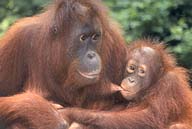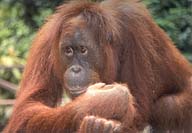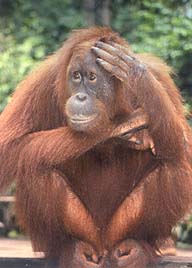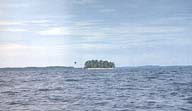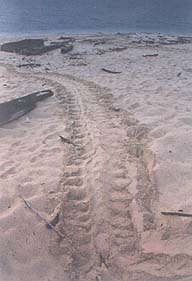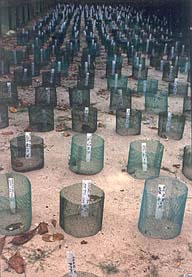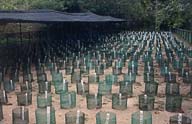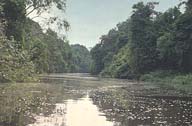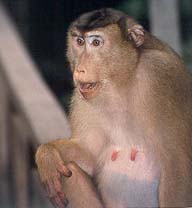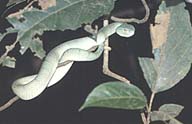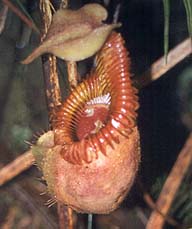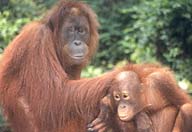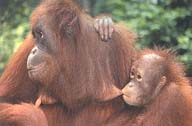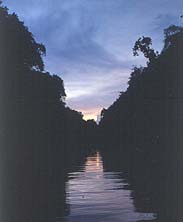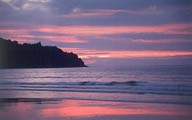The Good, the Bad and the Ugly - Conservation Holidays
The word spread quickly in the sleepy restaurant – a female green turtle had come ashore on the northernmost point of the island and had started to lay. There was a sudden blur of activity as sleep was rubbed from tired eyes, card games were discarded and torches gathered – it was all systems go.
Turtle Islands Park, situated some forty kilometres off Sandakan in Sabah, Malaysia, has for many years provided a haven and important breeding ground for the turtle and their long-term survival. Each evening dozens of turtles, returning to the beach where they themselves had hatched, come ashore to lay their eggs. Established in 1966, the marine park comprises the three islands of Selingan, Bakkungan Kechil and Gulisaan and the waters surrounding them - we were on Selingan, the only island accessible to tourists.
Yet despite being open to tourists, the park management has resisted the lure of the tourist dollar and restricted the number of visitors to Selingan to thirty. True that this constraint on numbers is partly due to the size of the island – it is eight hectares and takes some fifteen minutes to walk around – but the limiting of numbers is an integral part of the park’s management. The overwhelming message of my visit to the island was that its primary purpose was conservation.
Not only are numbers restricted but once on the island your visit is carefully orchestrated. On arrival in Selingan we were warmly welcomed by the rangers whilst at the same time politely told a number of important ‘do’s and don’ts’. These included no photography or walking on the beaches by ourselves after dark in case we disturbed turtles coming ashore to lay. Hence we had to wait in the restaurant until word came through on the radio that a turtle had begun laying.
Huddled behind a female turtle, whom was sighing with exhaustion and effort, was a moving experience and I felt privileged to be able to view this natural spectacle at such close range. I also felt happy in the knowledge that the individual efforts of the rangers as well as the conservation efforts on the island in general were actively contributing to the survival of the species. As soon as the turtle had laid her eggs they were carefully removed and reburied in a nearby hatchery in order to protect the eggs and give them a greater chance of hatching successfully.
In the hatchery, each clutch of eggs is counted, dated and then reburied. Some clutches are buried in the shade and some are not. I did not at first realise the significance of this until I looked around the excellent exhibition on the island, which details the life and habitat of the turtle and also the important work of conservation in the marine park. Here I learnt not only that the eggs take some sixty days to hatch but being reptiles the sex of the egg is determined by its temperature during incubation – the eggs in the shade would be cooler than those in the sun and would hatch as males.
The highlight of my stay on the island was helping the rangers to release the new hatchlings. Thankfully we did not have to wait sixty days to see this but were able to see baby turtles from a clutch laid two months previously. Holding a little baby in my hands was a special moment – it was very delicate and I had to be careful not to crush it’s shell yet at the same time it was immensely strong for its size. Its flippers flapped frantically in the air, eager to get started in life.
In the short time that I held ‘my’ turtle in my hands, I became quite attached to him and decided to christen him. I named him Cedric, much more original than Michaelangleo, Raphael or the very common Tommy. No sooner had I done so, I was cruelly reminded of the statistic that less than three per cent of hatchlings make it to maturity and decided not to release Cedric to his fate in the cruel sea. However my plan to save Cedric from awaiting predators was foiled as we (the tourists) were not allowed to release the babies ourselves but had to return them to the rangers. This is partly to prevent emotional weakness such as mine but more importantly to ensure that the hatchlings are properly placed on the beach so that it is forever imprinted in their memory and that one day they will return to lay their own eggs on this very same beach.
The image of eighty hatchlings scrambling across the beach to the false security of the sea has certainly been imprinted on my memory. But most of all it was Cedric’s reluctance to enter the sea that I shall never forget. The other hatchlings had already been swept up by the surf but Cedric lingered behind, awkward and disorientated. Perhaps he was confused by his religion, perhaps he had a greater awareness of statistics than his siblings or maybe he was just a turtle who was afraid of the sea. Whatever his reasons for procrastinating he did eventually make it to the sea, but to what end I shall never know.
But what I do know is that I was impressed with Selingan Island and that it is a good example of eco-tourism. Unfortunately the increasing vogue of eco-tourism has meant that it is a much used and more often than not misused term - all too often nature tourism is confused with eco-tourism. Nature tourism is travel for the purpose of enjoying underdeveloped areas of wildlife and thus includes mass tourism, adventure tourism and low impact tourism and eco-tourism. Aspects of eco-tourism may well be included in it, but nature tourism does not necessarily help conserve species or help crucially important local populations. Eco-tourism on the other hand is more specific, composed of components such as conservation, environmental education, local benefits and economic development, all of which are apparent on Turtle Island, and hence the more positive outlook for the turtles.
Sadly this is not so for the orang-utan, the man of the forest and gentlest of creatures, and the second ‘conservation’ area that I visited in Sabah. The orang-utan was once found throughout Southeast Asia but now the species only survives in relic populations on the islands of Borneo and Sumatra. Only ten years ago the estimated population was approximately 27,000, today the population has declined drastically and recent estimates suggest that it could be as low as 15,000. It is a poor indictment of man that within 10 years his closet relative (orang-utan’s share 97% of our genetic make-up) could be extinct.
The main reason that orang-utans are in such grave danger of extinction is that their rainforest habitat is being converted for human use - the biggest threat being permanent agriculture in the form of palm oil plantations and more recently illegal logging within protected areas. The establishment of palm oil plantations has had a devastating effect on the environment, for both wildlife and communities, as large tracts of primary rainforest have to be cleared to form a plantation. Oil palms are then planted in orderly rows, as a mono-culture (a plantation of only one tree species), reducing the bio-diversity and making what was once a mature forest available for a wide variety of animals and birds inhospitable and incapable of supporting many indigenous life forms.
The orang-utan’s status exactly mirrors that of the Mountain Gorillas. The prediction of Dian Fossey in her book ‘Gorillas in the Mist’ where she laments the fact that the Mountain Gorilla would be scientifically discovered and made extinct in the same century, has thankfully proved unfounded. One of the principle reasons for their salvation lies in the permit, which costs US$250 per visitor, to see the gorillas. The permits raise very significant amounts of money for their conservation and means governments like those in Uganda protect these creatures with whole armies, so valuable are they to the country’s economy.
Sadly no such value has been placed on the orang-utan. Every year tens of thousands of tourists pass through the gates of Sepilok Orang-utan Sanctuary, a sanctuary that does much good work in rehabilitating orang-utans to the wild, yet they only pay RM 10 for the privilege (this will increase to RM 60 in January 2002), and the vast majority stay for an hour at most. This is long enough for them to get their prized photograph but not long enough to really learn about the orang-utan, it’s environment and plight. Bussed into the sanctuary in air-conditioned splendour by large tour companies it is certain that they put little back into the local economy.
While thousands visit the semi-wild orang-utans of Sepilok every year, it is estimated that less than 5,000 people in the world have seen orang-utans in the wild. Why is this? Simply because most companies are interested in a quick buck rather than sustainable practice, they are involved in nature rather than eco tourism. Some might argue that nature tourism does contribute much to the environment and does do some good but such an argument is tenuous in light of a 50% decline in orang-utan numbers in the last few years.
The third area that I visited was that of the Kinanbatangan River home to orang-utan, macaques, red and silver leaf monkeys, elephants, and perhaps most famous of all the bizarre proboscis monkey. Every evening the proboscis monkeys emerge out of the forest rainforest to the river’s edge to drink and spend the night. My first contact with the monkey was one of sound not sight as a male despaired high in the trees above us, ‘Uh oh, Uh oh’. It sounded as though something was wrong or as if he was doing a poor impression of Forrest Gump but in fact he was saying it to placate his harem – a single male will look after a harem comprising several adult females and juveniles.
The proboscis monkey is renowned for the size of its nose but what I did not appreciate was the size of what our guide euphemistically referred to as his ‘red chilli’. Whilst I sought solace in the fact that the adage about the size of one’s nose might be true, I found little else to comfort me. How much longer I thought to myself?
The Kinanbatangan is fantastic and listening to the noise of the surrounding jungle, the calls of numerous birds, the yapping of a gecko and the squeaking of a tree frog, was fascinating. It certainly lived up to it’s billing by various tourist pamphlets although the phrase that it contained “the greatest concentration of wildlife in Malaysia and possibly all Borneo” did stick in my mind – I feared that this concentration was only due to the fact that there was no alternative habitat. Driving to Kinanbatangan I was shocked by the extent of the palm plantations and how much they were encroaching on the rainforest. The outlook for the forest and the proboscis monkeys is not good against the highly profitable palm oil plantations. But what can we do? We need to change our way of thinking, perhaps starting with an old saying “Money does grow on trees” (sic).
In this year of Ecotourism, so proclaimed by the United Nations, green is the new fashion in the travel industry. The travel industry and particularly nature travel is in theory one of the most sustainable and least resource extractive activities that we can hope to find. It is based on the premise that what we see and experience will be there again tomorrow for someone else to view and experience. So why is the tourism industry finding it collectively so hard to achieve an element of sustainability? Nobody can tell me that it really only costs us £10 to fly to Majorca, that Dominica receives any benefit whatsoever from cruise liners arriving for three hours and off loading 600 passengers, that it only really costs 7 pence for a Visitors Park fee to run a National Park in Borneo.
Firstly demand. Quite simply too few people demand or expect better holidays with more attention to the local environment and local communities and until this happens little will change. Real change will only happen on the basis of heightened awareness of the real costs to the environment and peoples of one’s holiday and this really only happens after a major disaster. Take British farming as an example of this.
Secondly, the media. It is interesting that whenever a Holiday TV programme is aired featuring a ‘green’ holiday viewing figures plummet. So we have to find methods and words that switch on travellers, not switch them off. Again it is achievable but the media needs to be bolder and more investigative in exploring these issues.
Finally cost. No other industry is so good at using (or polluting) the environment within which it makes its living yet so poor at paying for it, maintaining it or indeed supporting it. It is no longer right in the travel industry to think purely of economic return and profit but we should all now be moving towards a more rounded approach that takes in environmental and social returns too. Becoming a more sustainable industry is not an optional extra.
For all the bluster of the United Nations campaign it will be some time
before good words turn into serious action and until then British travel
green is more likely to be a matt grey. The outlook for the orang-utans
and proboscis monkeys is not good.
|
|
|
